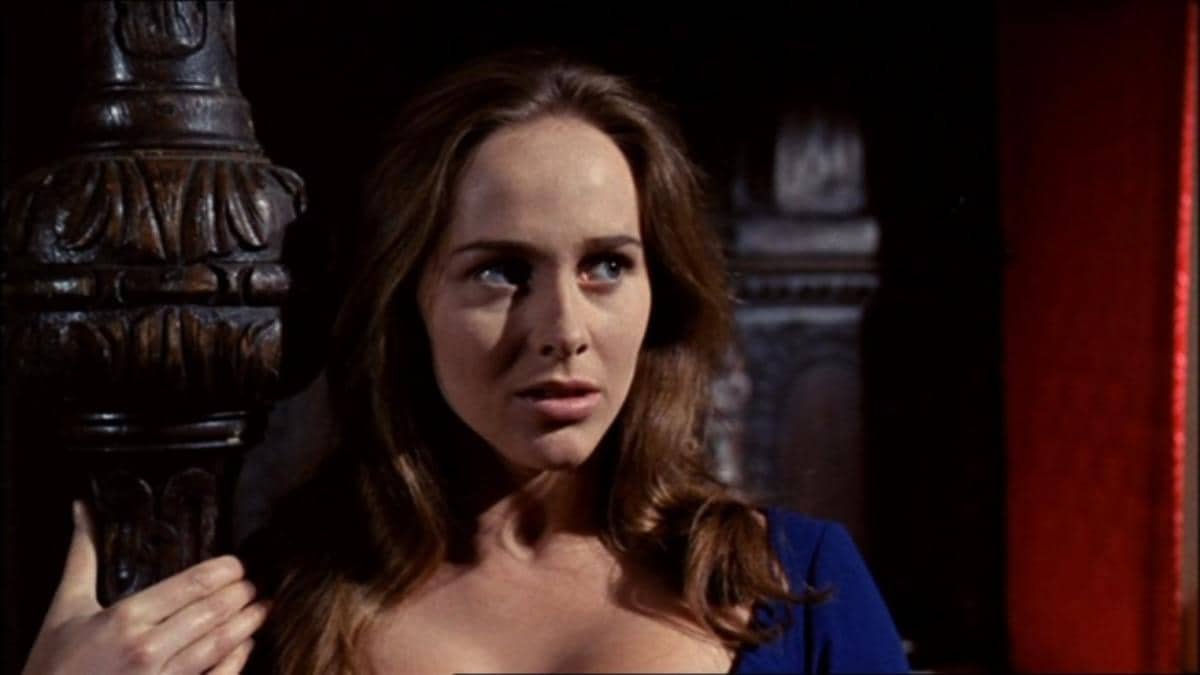[Editorial] In Her Eyes: Sara Lowes in Witchfinder General (1968)

In Witchfinder General we see the violent campaign of Matthew Hopkins, self-appointed Witchfinder General who cut a swathe through the English countryside during the English Civil War.
The film follows Hopkins as he paints the verdant fields of pastoral England with the blood of innocent people accused of witchcraft and consorting with the devil. One of these victims is Sara Lowes, a woman targeted first because of her affiliation with her uncle and then because Hopkins is, alongside being a murderer, racketeer and a general affront to humanity, also a sexual predator.
Whilst I would make no claims as to the historical accuracy of Witchfinder General, it isn’t difficult to relate the experience of Sara to the lived reality of women alive during Hopkins’ reign of terror. Sara is a woman condemned from the start, first because of her religious beliefs, that are suddenly in opposition with those held by the powers that be and then because she is a young, vibrant woman who catches the eye of evil men who have been taught that the world is theirs for the taking and have been given the ability to punish those who refuse them. It is unfortunate that this film, although made in 1968, doesn’t feel that far away from life for many women today, with sexual violence, social judgement and the danger of a lack of independence evident throughout the film.

Whilst the themes of sexual violence, misogyny and wider patriarchal structures aren’t explicitly explored in Witchfinder General, watching it through a contemporary lens does give rise to the interesting dynamics at play with all the men Sara comes into contact with. Her relationship with Richard is surprisingly modern and progressive, at least within their romantic relationship prior to the arrival of Matthew Hopkins, and in his treatment of her as a survivor of sexual violence. During a scene in Sara’s uncle’s church we see the word WITCH scrawled in enormous letters across a wall. This word, and all its associated horrors, are writ large on Sara’s face when she sees Richard’s return. She is adrift in a violent and unloving world and has to fear that the only person she has left will abandon her as well. Instead, whilst Richard wants revenge for Sara, he does not love her any less, or see her as ‘soiled’ or damaged as a result of Hopkin’s predation. This is in direct contrast to Hopkins himself, who, after finding out that his colleague Stearne has attacked Sara, loses all interest in her, and therefore in safeguarding her uncle. This serves to emphasise Richard’s role, at least at this point, as ‘hero’ and confirms Hopkins’ wickedness. It also raises interesting questions about the nature of sexual violence, particularly with regard to power dynamics. That Hopkins does not see himself as a rapist, because Sara ‘willingly’ sacrifices herself, but acknowledges that Stearne, with his overt display of violence, is a brute, shines a light on the nature of consent and how it can be weaponized.
CRAVING EXCLUSIVE EXTRA CONTENT? CHECK THESE OUT!
![[Ghouls Podcast] Maniac (2012) with Zoë Rose Smith and Iona Smith](https://images.squarespace-cdn.com/content/v1/5fe76a518d20536a3fbd7246/1696356006789-NYTG9N3IXCW9ZTIJPLX2/maniac.jpg)
Whilst Sara spends much of the film either fleeing from men, or running towards them, she is also an independent player in her own life. When she offers herself sexually to Hopkins, in exchange for her uncle’s safety, she demonstrates that she is not naïve or unaware of the nature of the world. When she finds herself in danger later in the film, she is vocal in her concerns. She watches the violence metered out by Hopkins and Stearne, seeing the horror for herself and does not turn away.
However, this horror, predictably, takes its toll. At the close of the film we see Sara dissolving into the ruins of her life, screaming uncontrollably in the face of violence and torture. It is a stark reminder that revenge can never right the wrong it seeks to punish, nor can it remove pain, or the memory of suffering. Throughout the film, Sara is a woman who suffers greatly for her relationship with the men around her. First, her uncle who, even when aware of imminent danger, doesn’t do enough to safeguard her. Then Matthew Hopkins who sees in her an opportunity to exert his small, cruel need for power and control.

Also Stearne attacks Sara out of a perverse jealousy because cannot stand to see Hopkins keeping something from him. And finally, Richard, who has become so driven by the desire for revenge that he has forgotten the love that inspired it. In his final revenge on Hopkins, we can see that it does not stem from a need to protect Sara, but out of a longing to reclaim what was stolen from him. This is not about Sara’s pain, or helping her to heal from the trauma she has suffered. This is a poignant ending when taken in the context of the witch trials specifically, a time when women were accused by friends, neighbours and even their own family, and, more generally, the ongoing treatment of women to this day. Sara is a vivid representation of all the women who have suffered at the hands of wickedness perpetrated by sinners like Matthew Hopkins and the communities that enable them and in that way she remains an important figure for analysis today.
RELATED ARTICLES
Possessor is a slick futuristic thriller in which Tasya Vos, an assassin for hire, must manage her responsibilities as an elite killing machine and complex feelings towards her husband and son, whilst taking on another high-profile job that will push her to the edge of her sanity.
Sara is a woman condemned from the start, first because of her religious beliefs…
The Babadook is a 2014 psychological horror, the directorial debut of Jennifer Kent…
Helen Lyle is a triple threat. She is smart, charismatic and tenacious. An innovative researcher who wants to push the envelope. ..
When James Wan’s The Conjuring (2013) was first released, it set the tone for 2010s horror and was regarded by some horror fans as the beginning of a renaissance for the genre…
Sara is host of a failing web series entitled Encounters which shows her meeting a range of offbeat people through personal ads…
It’s not wholly obvious in the first thirty minutes of Tobe Hooper’s The Texas Chainsaw Massacre just who our final girl will be…
Filmdom’s conventional wisdom in the mid-20th Century decreed that horror was no place for a lady. That is, unless it was as a shrieking victim dressed in a bosom-baring, diaphanous nightie…
When reassessing The Exorcist, there are implications of abuse brought on by Chris MacNeil’s reluctance to be a proper ‘mother’ to Regan…
Everyone must play, no outsiders allowed, nobody leaves.

EXPLORE
Now it’s time for Soho’s main 2023 event, which is presented over two weekends: a live film festival at the Whirled Cinema in Brixton, London, and an online festival a week later. Both have very rich and varied programmes (with no overlap this year), with something for every horror fan.
In the six years since its release the Nintendo Switch has amassed an extensive catalogue of games, with everything from puzzle platformer games to cute farming sims to, uh, whatever Waifu Uncovered is.
A Quiet Place (2018) opens 89 days after a race of extremely sound-sensitive creatures show up on Earth, perhaps from an exterritorial source. If you make any noise, even the slightest sound, you’re likely to be pounced upon by these extremely strong and staggeringly fast creatures and suffer a brutal death.
If you like cults, sacrificial parties, and lesbian undertones then Mona Awad’s Bunny is the book for you. Samantha, a student at a prestigious art university, feels isolated from her cliquey classmates, ‘the bunnies’.
The slasher sub genre has always been huge in the world of horror, but after the ‘70s and ‘80s introduced classic characters like Freddy Krueger, Michael Myers, Leatherface, and Jason, it’s not harsh to say that the ‘90s was slightly lacking in the icon department.
Mother is God in the eyes of a child, and it seems God has abandoned the town of Silent Hill. Silent Hill is not a place you want to visit.
Being able to see into the future or back into the past is a superpower that a lot of us would like to have. And while it may seem cool, in horror movies it usually involves characters being sucked into terrifying situations as they try to save themselves or other people with the information they’ve gleaned in their visions.
Both the original Pet Sematary (1989) and its 2019 remake are stories about the way death and grief can affect people in different ways. And while the films centre on Louis Creed and his increasingly terrible decision-making process, there’s no doubt that the story wouldn’t pack the same punch or make the same sense without his wife, Rachel.
The story focuses on a group of survivors after most of the world’s population is wiped out by Captain Trips, a lethal super-flu. And while there are enough horrors to go around in a story like this, the real focus of King’s book is how those who survive react to the changing world around them.
While some films successfully opt to leave the transformation scene out completely, like the wonderful Dog Soldiers (2002), those who decide to include it need to make sure they get it right, or it can kill the whole vibe of the film. So load up on silver bullets, mark your calendar for the next full moon, and check out 11 of the best werewolf transformations!


![[Ghouls Podcast] The Last House on the Left (2009) with Zoë Rose Smith and Jerry Sampson](https://images.squarespace-cdn.com/content/v1/5fe76a518d20536a3fbd7246/1687863043713-54DU6B9RC44T2JTAHCBZ/last+house+on+the+left.jpg)
![[Ghouls Podcast] The Bay (2012) with Ariel Powers-Schaub & Amber T](https://images.squarespace-cdn.com/content/v1/5fe76a518d20536a3fbd7246/1684751617262-6K18IE7AO805SFPV0MFZ/The+Bay+website+image.jpg)
![[Ghouls Podcast] Picnic at Hanging Rock (1975) with Zoë Rose Smith & Rebecca McCallum](https://images.squarespace-cdn.com/content/v1/5fe76a518d20536a3fbd7246/1682536446302-I2Y5IP19GUBXGWY0T85V/picnic+at+hanging+rock.jpg)
![[Ghouls Podcast] Psychotic Women in Horror with Zoë Rose Smith & Mary Wild](https://images.squarespace-cdn.com/content/v1/5fe76a518d20536a3fbd7246/1678635495097-X9TXM86VQDWCQXCP9E2L/Copy+of+Copy+of+Copy+of+GHOULS+PODCAST+THE+LOVED+ONES.jpg)
![[Ghouls Podcast] Nekromantik with Zoë Rose Smith & Rebecca McCallum](https://images.squarespace-cdn.com/content/v1/5fe76a518d20536a3fbd7246/1677422649033-Z4HHPKPLUPIDO38MQELK/feb+member+podcast.jpg)
![[Ghouls Podcast] Final Destination 5 & Wrap-up with Ariel Powers-Schaub & Iona Smith](https://images.squarespace-cdn.com/content/v1/5fe76a518d20536a3fbd7246/1672841326335-WER2JXX7WP6PO8JM9WB2/PODCAST+BONUS+2023+%284%29.jpg)
![[Ghouls Podcast] Final Destination 3 & 4 with Ariel Powers-Schaub & Iona Smith](https://images.squarespace-cdn.com/content/v1/5fe76a518d20536a3fbd7246/1672841151148-U152EBCTCOP4MP9VNE70/PODCAST+BONUS+2023+%283%29.jpg)
![[Ghouls Podcast] Final Destination 1 & 2 with Ariel Powers-Schaub & Iona Smith](https://images.squarespace-cdn.com/content/v1/5fe76a518d20536a3fbd7246/1672841181605-5JOOW88EDHGQUXSRHVEF/PODCAST+BONUS+2023+%282%29.jpg)
![[Ghouls Podcast] Henry: Portrait of a Serial Killer (1986)](https://images.squarespace-cdn.com/content/v1/5fe76a518d20536a3fbd7246/1672841247731-65K0JKNC45PJE9VZH5SB/PODCAST+BONUS+2023+%281%29.jpg)
![[Ghouls Podcast] A Serbian Film with Rebecca and Zoë](https://images.squarespace-cdn.com/content/v1/5fe76a518d20536a3fbd7246/1672841382382-RY0U5K7XD4SQSTXL2D14/PODCAST+BONUS+2023.jpg)
![[Editorial] In Her Eyes: Tasya Vos in Possessor (2020)](https://images.squarespace-cdn.com/content/v1/5fe76a518d20536a3fbd7246/1667061747115-NTIJ7V5H2ULIEIF32GD0/Image+1+%285%29.jpg)
![[Editorial] In Her Eyes: Sara Lowes in Witchfinder General (1968)](https://images.squarespace-cdn.com/content/v1/5fe76a518d20536a3fbd7246/1655655953171-8K41IZ1LXSR2YMKD7DW6/hilary-heath.jpeg)
![[Editorial] The Babadook (2014)](https://images.squarespace-cdn.com/content/v1/5fe76a518d20536a3fbd7246/1651937631847-KR77SQHST1EJO2729G7A/Image+1.jpg)
![[Editorial] In Her Eyes: Helen Lyle in Candyman (1992)](https://images.squarespace-cdn.com/content/v1/5fe76a518d20536a3fbd7246/1649586854587-DSTKM28SSHB821NEY7AT/image1.jpg)
![[Editorial] Lorraine Warren’s Clairvoyant Gift](https://images.squarespace-cdn.com/content/v1/5fe76a518d20536a3fbd7246/1648576580495-0O40265VK7RN03R515UO/Image+1+%281%29.jpg)
![[Editorial] Sara in Creep 2 (2017)](https://images.squarespace-cdn.com/content/v1/5fe76a518d20536a3fbd7246/1646478850646-1LMY555QYGCM1GEXPZYM/27ebc013-d50a-4b5c-ad9c-8f8a9d07dc93.jpg)
![[Editorial] Sally Hardesty in The Texas Chainsaw Massacre (1974)](https://images.squarespace-cdn.com/content/v1/5fe76a518d20536a3fbd7246/1637247162929-519YCRBQL6LWXXAS8293/the-texas-chainsaw-final-girl-1626988801.jpeg)
![[Editorial] Margaret Robinson: Hammer’s Puppeteer](https://images.squarespace-cdn.com/content/v1/5fe76a518d20536a3fbd7246/1630075489815-33JJN9LSGGKSQ68IGJ9H/MV5BMjAxMDcwNDI2Nl5BMl5BanBnXkFtZTcwOTMxODgzMQ%40%40._V1_.jpg)
![[Editorial] Re-assessing The Exorcist: Religion, Abuse, and The Rise of the Feminist Mother.](https://images.squarespace-cdn.com/content/v1/5fe76a518d20536a3fbd7246/1629995626135-T5K61DZVA1WN50K8ULID/image2.jpg)
![[Editorial] Unravelling Mitzi Peirone’s Braid (2018)](https://images.squarespace-cdn.com/content/v1/5fe76a518d20536a3fbd7246/1628359114427-5V6LFNRNV6SD81PUDQJZ/4.jpg)






















![[Editorial] 10 Films & Events to Catch at Soho Horror Film Fest 2023](https://images.squarespace-cdn.com/content/v1/5fe76a518d20536a3fbd7246/1700819417135-299R7L4P0B676AD3RO1X/Screenshot+2023-11-24+at+09.41.52.png)
![[Editorial] 9 Horror Nintendo Switch Games To Play](https://images.squarespace-cdn.com/content/v1/5fe76a518d20536a3fbd7246/1697214470057-3XZXX8N4LYIMDFWS6Z3P/Screenshot+2023-10-13+at+17.20.13.png)
![[Mother of Fears] Mothering in Silence in A Quiet Place (2018)](https://images.squarespace-cdn.com/content/v1/5fe76a518d20536a3fbd7246/1696445921315-HZJ2DZYQIH6VVWXBO2YL/Screenshot+2023-10-04+at+19.52.29.png)
![[Editorial] 5 Female Focused Horror Book Recommendations](https://images.squarespace-cdn.com/content/v1/5fe76a518d20536a3fbd7246/1696441981361-52EQCTJ7AT2QF1927GM7/919xtm6d3fL._AC_UF894%2C1000_QL80_.jpg)
![[Editorial] 9 Best Slashers Released Within 10 Years of Scream (1996)](https://images.squarespace-cdn.com/content/v1/5fe76a518d20536a3fbd7246/1695478839037-LOFHGVM3H6BMSZW7G83M/Screenshot+2023-09-23+at+15.15.11.png)
![[Mother of Fears] Mother Vs. Monster in Silent Hill (2006)](https://images.squarespace-cdn.com/content/v1/5fe76a518d20536a3fbd7246/1695485781119-H6GNP0G3J2TLPAOIABV7/Screenshot+2023-09-23+at+17.11.56.png)
![[Editorial] 9 Terrifying Cerebral Visions in Horror Movies](https://images.squarespace-cdn.com/content/v1/5fe76a518d20536a3fbd7246/1693509801235-X23OL50T1DVGECH0ZJK2/MV5BMjQ0MTg2MjQ4MV5BMl5BanBnXkFtZTgwMTU3NDgxMTI%40._V1_.jpg)
![[Mother of Fears] I Don’t Wanna Be Buried in a Pet Sematary (1989) and (2019)](https://images.squarespace-cdn.com/content/v1/5fe76a518d20536a3fbd7246/1691328766069-QFNAVJOMFZVZ5CLU1RWM/Screenshot+2023-08-06+at+14.23.13.png)
![[Mother of Fears] How I Love to Love Nadine in The Stand (2020)](https://images.squarespace-cdn.com/content/v1/5fe76a518d20536a3fbd7246/1690213172707-TKM9MZXK02EVCIX30M1V/Screenshot+2023-07-24+at+16.29.11.png)
![[Editorial] 11 Best Werewolf Transformations in Horror Films](https://images.squarespace-cdn.com/content/v1/5fe76a518d20536a3fbd7246/1689240234098-HUPQC6L57AAHFJNT8FTE/Screenshot+2023-07-13+at+10.09.13.png)
